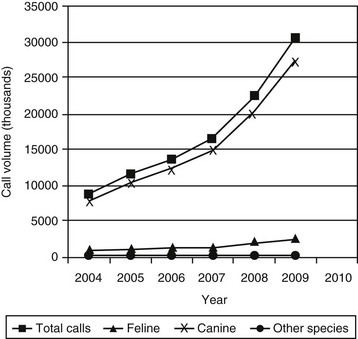Chapter 21 Call volumes for animal toxicology cases have increased steadily over the past several years (Figure 21-1). Whether this represents an actual increase in exposures, an increase in awareness and use of available animal toxicology services, or both is unclear. The call distribution represents a sample of the type of animal toxicology questions posed to small animal practitioners. The source of these calls, species affected, age of animals, and toxin and foreign body types are briefly summarized. Thirty-one deaths were reported during the 12-month period from July 1, 2010 to June 30, 2011 (Table 21-1). This number may be falsely low because some cases had unknown or undocumented outcomes. Twenty-four dogs, three cats, two guinea pigs, and one sugar glider died or were humanely euthanized. The most common cause of death in all species was from ingestion of human medications, followed by rodenticides; pesticides or other products used around the house and garden to eliminate insects, rodents, or weeds; and unknown toxins. Ten of the recorded deaths were due to unrelated causes (e.g., underlying disease conditions and neoplasia including hemangiosarcoma). TABLE 21-1 For the purpose of investigating the specific toxin/foreign body responsible for the call, calls were divided into nine general categories (Table 21-2) Subdivisions were used in each category as needed to further classify information. TABLE 21-2
Toxin Exposures in Small Animals
Species Affected
Category
Number of Deaths
House and garden
Insecticide
2
Metaldehyde
1
Rodenticide
2
Ethylene glycol
1
Caffeine
2
Human drugs (prescription and over-the-counter)
11
Household products
1
Xylitol
1
Other
10
Call Types
Call Type
Yearly Call Volume
Human drugs and nutraceuticals
>12,000
Pesticides
Rodenticides
1715
Fertilizers and plant foods
524
Insecticides
380
Herbicides
215
Metaldehyde
30
Plants
1408
Mushrooms
105
Mycotoxins
14
Food
Chocolate
1924
Xylitol
846
Vitis sp. (grapes, raisins, currants)
374
Allium sp. (onion, garlic, chives)
154
Coffee
102
Tea
85
Alcoholic beverages
59
Macadamia nuts
45
Bread/bread dough
29
Household products
Cleaners, disinfectants, bleach
840
Paint, stain, varnish
294
Soap
185
Batteries
125
Pool and spa chemicals
67
Air fresheners, potpourri
58
Deodorant
47
Other (primarily automotive)
Ethylene glycol
54
Brake fluid
20
Transmission fluid
8
Veterinary drugs
>2400 ![]()
Stay updated, free articles. Join our Telegram channel

Full access? Get Clinical Tree



